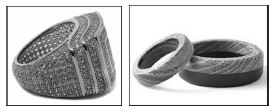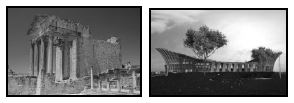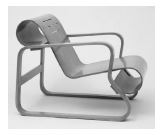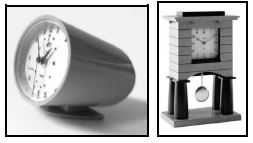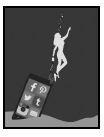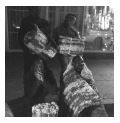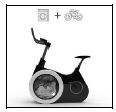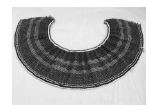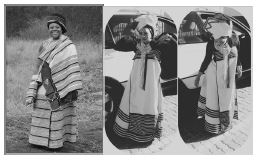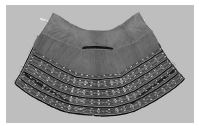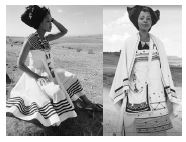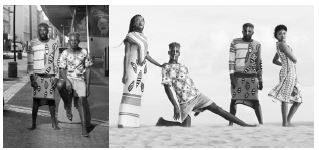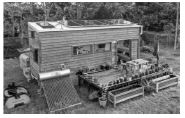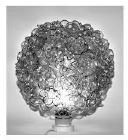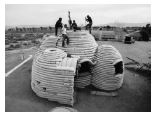DESIGN PAPER 1 GRADE 12 MEMORANDUM - NSC EXAMS PAST PAPERS AND MEMOS MAY/JUNE 2021
Share via Whatsapp Join our WhatsApp Group Join our Telegram GroupDESIGN PAPER 1
GRADE 12
NATIONAL SENIOR CERTIFICATE EXAMINATIONS
MAY/JUNE 2021
SECTION A: DESIGN LITERACY
'UNSEEN' EXAMPLES
ANSWER EITHER QUESTION 1.1 OR QUESTION 1.2.
QUESTION 1 [10 Marks]
1.1 (Allocate a maximum of 2 marks per design term for a total of 10 marks)
The illustration makes use of clear outlines which flatten the images and helps to simplify them.✓ The lines are mostly curvilinear and organic, for example around the title, the hair and the human figure, creating an image which is full of energy.✓ The diagonal line of the bent leg and the shield also adds dynamism to the work.✓ The lines around the words 'Nandipha' seem to be vibrating and just above the words are lines that suggest sunrays or an explosion. The use of these lines emphasises that 'Nandipha' is a powerful person.✓
The shapes have been stylised to create simple images that 'read' easily and are suitable to illustrate a story.✓ Organic flowing shapes dominate, for example the body and the shape in which the title is placed and the 'hill' behind which the figure is standing.✓ Some geometric shapes are used to contrast with these organic shapes and to stabilise the movement, for example the block-like city skyline and the angular shape of the shield.✓
The field of black around the title creates a strong contrast with the yellow lettering making that area a focal point.✓ The black figure also contrasts with the brightly coloured clothing and sky creating a vibrant image.✓
The textures of the images are mostly smooth with detail indicated in line. The smooth surfaces also help to create clear images that can be easily understood.✓ The hair consists of many flowing long lined textures that suggest wild, loose strands of hair.✓ The repetition of short diagonal lines (the shield, protective attire) creates an illusion of rough texture.✓
Warm colours like cream, light and dark orange as well as maroon dominate the illustration, adding to the general atmosphere of excitement.✓ The cold turquoise on her skirt, as well as the cold purple in the buildings contrasts with all the warm colours and this contrast also adds drama to the scene.✓
Credit must be given to any other valid statements.
| Q.1.1 LEVEL | COGNITIVE SKILLS | WEIGHTING | QUESTIONS | MARKS (10) |
| Lower Order | Remember, Recall, Recognise | 30% | 1.1 | 2 |
| Understand, Explain, Describe | 1.1 | 1 | ||
| Middle Order | Apply, Implement, Organise | 40% | 1.1 | 3 1 |
| Higher Order | Analyse, Interpret | 30% | 1.1 | 3 |
| Reflect, Judge | ||||
| Synthesis |
OR
1.2
1.2.1 (Allocate 2 marks per design term for a total of 8 marks)
The repetition of many tiny petal shapes in FIGURE B creates a regular scalloped rhythmic pattern.✓ The inner rows curl inwards and the outer rows curl outwards, creating a range of different rhythms.✓ Rhythmic pattern is encased in a perfect circle creating controlled movement.✓
Because the repetitive petals are three-dimensional the bowl consists of tactile texture.✓ This texture appears sharp and rippling, this is created by the zigzag line formed by the repeated scallops.✓ The fact that the bowl is made from a type of plastic suggests that the actual texture is also hard. The bowl in the centre is smooth and looks cold and machine-like.✓
The colour of the bowl is white which gives it a pure and calm quality.✓ The shadows of the many petals add a variety of different greys emphasising the three-dimensional quality of the bowl.✓
From the front, the bowl appears to be symmetrically balanced with the left-hand side an exact mirror image of the right-hand side. This adds to the general sense of order.✓ From the top, the bowl appears to be radially balanced reminding one of sunrays, emphasising a spiritual quality.✓
1.2.2 (Allocate 2 marks)
Biomimicry is a study of design in nature that imitates the natural world to solve human challenges.✓ The bowl mimics the structure/form of a Chrysanthemum flower. The hollow and circular form of the flower allows the bowl to become a functional product.✓ The bowl is inspired by the perfect order found in the rhythms of nature.✓
Credit must be given to any other valid statements.
| Q.1.2 LEVEL | COGNITIVE SKILLS | WEIGHTING | QUESTIONS | MARKS (10) |
| Lower Order | Remember, Recall, Recognise | 30% | 1.2.1 | 1 |
| Understand, Explain, Describe, Classify | 1.2.1 | 2 | ||
| Middle Order | Apply, Implement, Organise | 40% | 1.2.1 1.2.2 | 3 1 |
| Higher Order | Analyse, Interpret | 30% | 1.2.1 | 1 |
| Reflect, Judge | 1.2.1 | 1 | ||
| Synthesis, Justify | 1.2.2 | 1 |
COMMUNICATION THROUGH DESIGN
QUESTION 2 [10 marks]
2.1 (Allocate 6 marks)
The use of white✓ symbolises peace and purity.✓ The colour red✓ symbolises love/blood.✓ The clenched fist✓ symbolises strength.✓ The image of the woman✓/flower✓ symbolises femininity.✓ The circle✓ with an attached cross symbolises the female gender.✓ A doily✓ symbolises femininity as doily making is considered a female pastime.✓
Credit must be given to any other valid statements.
2.2(Allocate 4 marks)
There is a longstanding stereotype in society that labels women as people who like to argue and question things mindlessly.✓ The designer dispels this stereotype by using the image of a bold and individual female who does not fit the traditional stereotype of a woman✓ and associates her with the profession of lawyer that uses strategy to dispute and question allegations.✓
The designer's use of imagery and wording seeks to dispel the stereotype that women are argumentative for the purposes of fun.✓ The designer achieves this visually by using positive visual and textual associations to counter this perception.✓
The designer uses white text, and the woman is dressed in a white shirt to project peace in countering the stereotype that women are violent and feisty.✓ The body language of the woman is self-assured and firm.✓
The Identification and motivation of religious and cultural stereotypes may also be credited.
Credit must be given to any other valid statements.
| Q.2 LEVEL | COGNITIVE SKILLS | WEIGHTING | QUESTIONS | MARKS (10) |
| Lower Order | Remember, Recall, Recognise, Name | 30% | 2.1 | 3 |
| Middle Order | Apply, Implement, Organise | 40% | 2.1 2.2 | 3 1 |
| Higher Order | Analyse,Compare, Interpret | 30% | ||
| Evaluate, Reflect, Judge | 2.2 | 3 | ||
| Synthesis, Justify |
QUESTION 3 [10 marks]
ANSWER EITHER QUESTION 3.1 OR QUESTION 3.2.
3.1 (Allocate 10 marks in total)
Both FIGURE E and FIGURE F use natural materials to execute the final product although FIGURE E uses gold plated metal in a pavé setting ✓ as material whereas FIGURE F is made out of wood, which is an organic material.✓ The gold and diamante ring is flashy and could be worn by users that want to flaunt their wealth, whereas the wooden rings would appeal to users that believe in simplicity and are environmentally conscious. ✓
Both FIGURE E and FIGURE F show natural colour on the outside finish of the product.✓ The gold colour of FIGURE E has a bling connotation and suggests wealth and excess✓, whereas the natural earthy browns and the smoothness of the wood used in FIGURE F suggests simplicity and humility. ✓
FIGURE E shows the influence of modern industrial technology (machine made) ✓ compared to FIGURE F that reflects a typical hand-made Arts and Crafts influence.✓ FIGURE E echoes the glitz and glamour of urban lifestyle✓ unlike FIGURE F that could reveal a calm rural lifestyle.✓
The form of FIGURE E is chunky, uneven and textured throughout with diamante. ✓ The front of the ring is slightly elongated and protruding ✓ by comparison, the form of FIGURE F is round, even, smooth and continuous like a tube.✓
Both FIGURE E and FIGURE F are rings, which function to adorn or beautify fingers.✓ Both may also function to indicate that the wearer is either married or engaged to be married.✓ These rings can also be indicative of the wearer's choice of lifestyle, for example, the wearer of FIGURE E may be associated with the hip-hop culture and the wearer of FIGURE F may be associated with a more natural and sustainable lifestyle.✓
Credit must be given to any other valid statements.
NOTE: A maximum of ONLY 3 marks may be allocated to tabular comparison responses. A maximum of ONLY 6 marks may be allocated where candidates present two separate essays that show a substantial comparison. Use the cognitive level grid as a guideline for your marking.
| Q.3.1 LEVEL | COGNITIVE SKILLS | WEIGHTING | QUESTIONS | MARKS (10) |
| Lower Order | Remember, Recall, Recognise | 30% | 3.1 | 1 |
| Understand , Explain, Describe | 3.1 | 2 | ||
| Middle Order | Apply, Implement, Organise | 40% | 3.1 | 4 |
| Higher Order | Analyse, Compare, Interpret | 30% | 3.1 | 2 |
| Evaluate, Reflect, | 3.1 | |||
| Create, Synthesis | 3.1 | 1 |
3.2 (Allocate 10 marks in total)
The Capitol in Dougga (FIGURE G) is the most impressive of one of twelve temples in Tunisia, Africa, constructed in 166 ACE. This impressive Roman temple is dedicated to the Capitoline Triad: Jupiter, Juno and Minerva. The material used to build the Capitol was locally sourced stone with floors that were inlaid with mosaic.✓ In comparison, the body of the proposed 2013 Judicial Law Court project in Meru, Kenya, (FIGURE H) will be constructed from concrete with bamboo roof trusses.✓ The use of bamboo reduces the building costs and as it is a natural material it is environmentally friendly. Due to its strength and the fact that it naturally occurs in long lengths larger areas can be spanned.✓
After Kenya's Chief Justice announced long term plans for more spaces and buildings that can function as justice buildings, Dennis Mukuba, a student from Nairobi University proposed this design for a High Court in Meru.✓ Similarly the Capitol was situated in an ancient administrative centre and functioned as a building to house the statues of the venerated/worshipped patron gods. ✓ Contemporary buildings such as the High court in Meru's function are to accommodate the users and their needs whereas Classical temples were designed not for use by the worshippers but to house the statues of their gods.✓ The marble statues of the Triad gods of Dougga are housed within niches below a coffered wooden ceiling.✓
The Capitol Temple is situated high up on a hill; the site provided a panoramic view of the fertile valleys of Dougga, Tunisia below.✓ When viewed from the valley below the site allows the Capitol to dominate the arid landscape, creating an imposing impression and communicating the power of the Emperor.✓ In contrast to this lofty site, the site for the Judicial Law Court of Meru (FIGURE H) slopes down toward the Kathita river.
The curving vertical concrete fins that form the shell structure of the Judicial Court of Meru (FIGURE H) reflects the source of inspiration as a tree.✓ The entire shell structure forms an exoskeleton which supports the concrete floor slabs. The vertical outward-curving fins create solid volumes that span the perimeter.✓ Not only are the outward-curving concrete fins an aesthetic consideration, but they also provide shade for the lower-level facades. The structure makes use of natural day lighting which can be enhanced by the inclusion of well shaded roof lights.✓ In contrast to this contemporary, dynamic curving structure the typical Classical post and lintel, rectangular structure of the Capitol temple has a pediment and six vertical columns with Roman Corinthian capitals.✓
The Roman temple of Dougga (FIGURE G) is heavily influenced by the preceding Greek and Phoenician architectural styles which are evident in the post and lintel system as well as the columns and entablature.✓ The Judicial Court of Maseru (FIGURE H) is influenced by the users of the modern court system but also respects the elaborate traditional African court and in this case the Njuri Ncheke of the Meru community of Eastern Kenya.✓ Traditionally African court (Kgotla) is held by the elders under a tree hence the structural influence on the building. ✓ This is where the community can report their grievances and the council (the elders) ruling on the matter will be the final decision.✓
Credit must be given to any other valid statements or a comparison of a Classical and contemporary building that the candidate has studied.
NOTE: A maximum of ONLY 3 marks may be allocated to tabular comparison responses. A maximum of ONLY 6 marks may be allocated where candidates present two separate essays that show a substantial comparison. Use the cognitive level grid as a guideline for your marking.
| Q.3.2 LEVEL | COGNITIVE SKILLS | WEIGHTING | QUESTIONS | MARKS (10) |
| Lower Order | Remember, Recall, Recognise | 30% | 3.2.2 | 2 |
| Understand , Explain, Describe, Classify | 3.2.2 | 1 | ||
| Middle Order | Apply, Implement, Organise | 40% | 3.2.2 | 4 |
| Higher Order | Analyse, Compare, Interpret | 30% | 3.2.2 | 2 |
| Evaluate, Reflect, | ||||
| Create, Synthesis, Justify | 3.2.2 | 1 |
TOTAL SECTION A: 30
SECTION B: DESIGN HISTORY
QUESTION 4 [30 marks]
4.1 (Allocate 20 marks in total)
(Allocate 10 marks for each movement. Please note that only one mark can be allocated for the name of a designer and product for each movement. The candidate must refer to the quote for the full mark allocation. Please use the cognitive level grid as a guideline for your marking.)
This marking guideline supplies an answer for the following two possibilities:
Scandinavian AND Deconstructivism
Candidates may choose any two movements provided their statements are justified and relate to the quote.
Scandinavian Design
Scandinavian design aims to create designs that reflect both the beauty and comfort (ergonomic qualities) found in organic forms from nature. Products that have been mass-produced by machine using new technologies and materials are cost-effective and functional. ✓
Scandinavian design is influenced by the simplicity and machine-like feel of Bauhaus and Modernist designs.✓ They were also inspired by the socialist philosophies of the day and the idea of a democratic society where everything was made available to everyone.✓ Nature and the Northern climate with its long winters and few hours of sunlight inspired them to create bright, light and practical environments with clean lines.✓ The delicate, nature-inspired forms, graceful lines and colours of Art Nouveau fit the Scandinavian aesthetic well.✓
An important characteristic of Scandinavian design is that a balance between cost effectiveness, function and aesthetics is maintained.✓ Designs are minimalist emphasising simplicity, but they are not as minimalist as modernist designs.✓ Emphasis is placed on simple, clean lines which remind one of machine-inspired Bauhaus and modernist designs.✓ Because many designs include elegant, organic lines and shapes a softer, more human-centred effect is achieved.✓ The inspiration of nature is clearly seen in the decorations on ceramics and textiles that use stylised designs of flowers, plants, birds and animals.✓ The inclusion of wood from nature as a material also distinguishes Scandinavian design from Modernism (where machine-age materials such as steel, glass, concrete and plastics were used).✓
A good example of Scandinavian design is the Paimio Chair by Alvar Aalto (1949).✓ The form is simple and elegant reflecting the clean lines typical of Scandinavian design.✓ The simple, block-like arms remind one of the machine-inspired shapes of the Bauhaus.✓ This machine-effect is combined with organic 'scroll' forms at the top and bottom of the chair that refer to nature thus softening the design.✓ The use of light plywood, a new machine-produced material is also influenced by nature.✓ The chair was specially designed for patients with tuberculosis as its angled backrest and tensile flexibility allows for easy breathing.✓
Deconstructivism
Deconstructivist designers aimed to use the machine and technological advancements such as computer-aided design programmes and new high-tech materials to create designs that question and undermine acceptable standards and norms of design.✓ Their designs reject harmony, unity and balance, encouraging designs that are distorted, fragmented and often use forms that seem to defy gravity. ✓
Deconstructivist design is influenced by the mechanical, geometric and fragmented forms of Cubism.✓ They are also influenced by the Anti-Design movement's aim to undermine and question traditional conventions and norms of beauty by distorting forms, by sharpening and brightening colours and by making use of visual puns or ambiguities. ✓
Deconstructivist designs are often characterised by geometric and fragmented shapes which create a sense of movement or dynamism.✓ Displaced and distorted angular forms are often set within conflicting geometric or intercepting planes (flat surfaces that appear to cut across each other).✓ This emphasis on diagonals and geometric shapes and planes gives a very machine-like, technological feel to the designs.✓ A sense of visual chaos has been created provoking a feeling of uncertainty, shock or disruption to the viewer.✓ The structure rejects pure function and traditional ideas of harmony, unity and stability.✓ Materials such as steel, glass, titanium, aluminium and concrete dominate also giving these designs a very machine-like appearance.✓
The Foundation Louis Vuitton Contemporary Art and Performance Space by Frank Gehry is a good example of Deconstructivism.✓ It has been described as a 'cathedral of light' and a 'miracle of intelligence, creativity and technology'.✓ From afar, it resembles a product made by machine, i.e. a spaceship or a boat.✓ It consists of twelve separate 'sails' that encase the building and which obscures its function.✓
The building is fragmented and distorted. It is made up of sharp, clashing angles, skewed shapes and intercepting planes giving it a very dynamic quality very typical of Deconstructivism.✓ The use of glass gives it a weightless quality suggesting that is floating in the air.✓
Credit must be given to any other valid statements.
| Q.4.1 LEVEL | COGNITIVE SKILLS | WEIGHTING | QUESTIONS | MARKS (20) |
| Lower Order | Remember, Recall, Recognise | 30% | 4.1 | 2 |
| Understand , Explain, Describe, Classify | 4.1 | 4 | ||
| Middle Order | Apply, Implement, Organise | 40% | 4.1 | 8 |
| Higher Order | Analyse, Compare, Interpret | 30% | 4.1 | 2 |
| Evaluate, Reflect, | 4.1 | 1 | ||
| Create, Synthesis, Justify | 4.1 | 3 |
4.2 (Allocate 10 marks)
The unusual tubular lime-green clock in FIGURE I shows the influence of the Pop era's love for simple, child-like forms and bright colours.✓ It also shows the influence of the Anti-Design movement who turned their back on traditional design, making use of bright, gaudy colours and distorted forms.✓ The Postmodernist clock in FIGURE J is eclectic in style, also showing the influence of multiple movements.✓ Its legs remind one of classical Greek columns, whilst the simple, block-like casing of the clock and the simple circle of the pendulum is quite modernist in style.✓
Pop design emphasised 'the new', aiming to restyle products and to use new technology based on scientific research.✓ This can be seen in the use of a new, non-traditional form for the clock, as well as in the use of injection-moulded plastic, a new technology.✓ In contrast, Postmodern designers aimed to link modern elements with aspects from past styles - this can be seen in the use of classical Doric-style columns and wood, a traditional material, in FIGURE J.✓ Both designs aim to appeal to individual taste and use quirky, humorous, unexpected forms to achieve this.✓
The bright, flat colour of the clock in FIGURE I is typical of Pop design, expressing light-heartedness and fun,✓ whereas the clock in FIGURE J makes use of earthy brown, gold and charcoal expressing a more subdued, formal feeling not typical of Postmodernism.✓ Postmodernist designs usually include some brightly coloured elements to make them more appealing to the general public.✓
The circular and diagonal outlines that dominate the clock in FIGURE I exudes energy and fun, reflecting Pop Design's move away from the rigid, rectilinear style of modernism.✓ In contrast, the vertical and horizontal lines that dominate FIGURE J convey the stability and order typical of classical designs.✓ The severity of the block-like top is softened by the curved edges of the columns and the curved bottom edge of the square casing because the Postmodernists also aim to move away from the rectilinear style of modernism.✓
FIGURE I makes use of injection-moulded plastic, celebrating a favourite new inorganic material of the Pop era.✓ FIGURE J uses plywood for the top and an ebony wood-coating for the columns. Although plywood is a 20th century invention it appears natural and reminds one of traditional organic building materials.✓
Credit must be given to any other valid statements.
NOTE: A maximum of ONLY 3 marks may be allocated to tabular comparison responses. A maximum of ONLY 6 marks may be allocated when candidates present two separate essays that show a substantial comparison. Use the cognitive level grid as a guideline for your marking.
| Q.4.2 LEVEL | COGNITIVE SKILLS | WEIGHTING | QUESTIONS | MARKS (10) |
| Lower Order | Remember, Recall, Recognise, Name | 30% | 4.2 | 2 |
| Understand , Explain, Describe, Classify | 4.2 | 1 | ||
| Middle Order | Apply, Implement, Organise | 40% | 4.2 | 4 |
| Higher Order | Analyse, Compare, Interpret | 30% | 4.2 | 1 |
| Evaluate, Reflect, Judge | 4.2 | |||
| Create, Synthesis, Justify | 4.2 | 2 |
TOTAL SECTION B: 30
SECTION C: DESIGN IN A SOCIOCULTURAL/ENVIRONMENTAL AND SUSTAINABLE CONTEXT
QUESTION 5 [20 marks]
ANSWER EITHER QUESTION 5.1 OR QUESTION 5.2.
5.1 (Allocate 20 marks in total)
5.1.1 (Allocate 4 marks)
The designer of the poster in FIGURE K clearly communicates how our addiction to our cell phones and social media weighs us down and could eventually drown us. ✓ The image of the cell phone with the social media icons, Facebook, Pinterest, Twitter, Internet, etc., is much larger than the figure, emphasising the power of social media.✓ The cuffed hand and ankle cuffs and the air bubbles from the female all allude to the fact that she is trapped by, and drowning under the weight of social media. ✓ The cell phone is embedded in the sand showing how tough it is to escape from the addiction to our cell phone.✓ The uncomplicated layout of the poster is divided into 2 sections; water and sand. ✓ The silhouetted, simplified female shape is placed in the top right-hand section of the composition. The stylised, flat and schematically drawn cell phone is embedded in the seabed.✓ Both the sea water and seabed is presented as a flat area. A diagonal line is formed by placement of the female and cell phone – all helping to strengthen the downward diagonal movement in the composition.✓ The horizontal line created by the seabed contrasts with the dynamic diagonal line and this contrast reinforces the stifling effect of the embedded cell phone.✓
Credit any other valid statements.
5.1.2 Allocate 16 marks in total
(Allocate 8 marks per case study)
Allocate 1 mark for the name of the designer and the name of the product.
ONE CONTEMPORARY SOUTH AFRICAN DESIGNER/DESIGN GROUP:
Suzette Hendricks, plastic sleeping mats.✓
The designer aims to create sleeping mats and blankets for the homeless to keep warm.✓ Also, the designer aimed to repurpose plastic bags and reduce plastic waste.✓ The technique used by the designer involved the cutting of plastic bags into strips to make balls of plastic, which were thereafter crocheted to make the mats.✓ Plastic as a material provides good insulation from the cold and is also waterproof.✓ Plastic is also fairly inexpensive and easily accessible✓ therefore the mat is economical✓ to make. The use of plastic prevents people from stealing these mats from the homeless.✓
The designer addresses the social concerns of homelessness. ✓ Homeless people have no way of protecting themselves from the weather conditions such as rain, wind and cold.✓ The designer created the plastic sleeping mats to provide comfort and a surface to sleep on for homeless people.✓
ONE CONTEMPORARY INTERNATIONAL DESIGNER/DESIGN GROUP:
Dalian Nationalities University: The Bike Washing Machine or BiWa.✓
The product combines the function of a washing machine with that of a stationary exercising bicycle. The designer aims to keep you fit by exercising on a stationary bike✓ and at the same time performing the mundane chore of washing laundry.✓ The technique used by the product requires that the pedals of the bike spin and rotate the front wheel, which is a clothing drum.✓ The extra energy created through the workout powers the display screen and monitors the wash cycle process✓. The designer used different materials for different components like plastic as the body and pedals,✓ steel for the washing drum and rubber that serves as band to run the pulley between the pedals and the drum.✓ Each material used is for the benefit of the product to work as a unit and be durable.✓
In this product the designer addresses the sociocultural concern of lack of time to exercise and wash laundry.✓ Modern day living is so high paced that often people do not have enough time in a day to exercise that often results in obesity.✓ Also, with the high cost of food, fuel and other living expenses, most people cannot afford domestic help or the use of laundromats.✓ The designer addresses the socio-cultural concern of small living spaces by designing the exercising bicycle as one component product with multiple functions.✓
Credit any other valid statements.
| Q.5.1 LEVEL | COGNITIVE SKILLS | WEIGHTING | QUESTIONS | MARKS (20) |
| Lower Order | Remember, Recall, Recognise, Name | 30% | 5.1.1 | 2 |
| Understand , Explain, Describe, Classify | 5.1.2 | 4 | ||
| Middle Order | Apply, Implement, Organise | 40% | 5.1.1 5.1.2 | 2 6 |
| Higher Order | Analyse, Compare, Interpret | 30% | 5.1.2 | 3 |
| Evaluate, Reflect, Judge | 5.1.2 | 1 | ||
| Create, Synthesis, Justify | 5.1.2 | 2 |
5.2 Allocate 20 marks in total
5.2.1 (Allocate 2 marks)
The unusual chairs in FIGURE L belong to the category of both craft and/ or design. It is a craft as it is produced using a traditional hand weaving basket technique. The chairs are woven from reeds which is a traditional craft material.✓ The chair does not copy an already existing design but is unique, original and fuses traditional craft and contemporary design to form a product that will function well in a contemporary interior.✓
(Allocate 8 marks)
Traditional Xhosa female beaded dresses date back to pre-colonial times. The origins of the beaded Xhosa female skirt; the Isikhakha or Umbhaco stems from a rich tradition of beaded ceremonial dresses which have formed a major part of a cultural aesthetic expression in Southern Africa for nearly 200 years.✓
During the late eighteenth and early nineteenth century's glass beads were first imported in small numbers to Africa from Europe. They were exclusively the property of the ruling elite and symbolized their important status. By the end of the nineteenth century, Africa was the world's largest consumer of beads imported from Europe. Subsequently, the number and type of adornments fashioned from beads increased significantly, as beadwork was still considered a women's craft.✓
Within the Xhosa culture, the functional and social role of the Isikhakha or Umbhaco forms part of a complex dress code that is informed by a person's social standing. While beaded garments and accessories were used differently by various ethnic groups, in each society they played a key role in communicating aspects of the wearer's identity.✓ Social and marital status, number of children, and a person's home region and ethnic subgroup were, and often still are, communicated through items of dress.✓ Traditionally, women's clothing and accessories show the different stages of life. Traditional dresses are still valued and worn as a sign of respect to the ancestors. In earlier times, missionaries insisted that converts to Christianity abandon indigenous fashions. Those who still wore traditional clothes could easily be distinguished from the converts. The Xhosa term for traditionalist was amaQaba, the "Red People" because they continued to apply red ochre to their clothes and bodies.✓
Elaborate beaded necklaces called ithumbu, were worn around the neck with beaded bracelets and anklets.
The iqhiya or headscarf was traditionally worn by married women and to complete the outfit, embroidered capes or blankets were worn around the shoulders. The scarf is supposed to conceal the female figure as well as safeguard her fertility, while the 'doek' is a sign of respect towards the elders; a new bride cannot talk to the elders bare-headed.✓
5.2.2 Additionally, the colour of a dress is determined by the Xhosa sub-group, the specific region, and the social status of a person. The traditional Xhosa wedding attire, the Umakoti like in other African and Western culture, is usually the centre of attraction during a wedding ceremony. What the bride looks like is of particular importance to the days' proceedings as she has to display traditional symbolism and look exquisite to outshine every other woman in the ceremony.✓
Depending on the specific region and Xhosa subgroup, the materials, techniques and colouration of the textiles varied a great deal. The isikhakha or imibhaco is an elegant textile skirt that could incorporate beadwork and appliquéd strips.✓ Delicate beaded appliqué designs alternating with buttons were added between the rows. The skirt was worn with a beaded belt and beaded tassels that extend to the ground. The combination of elaborate beadwork with vividly hued textiles and other materials like buttons and tassels yielded both a rich, tactile surface and a beautiful effect.✓ Beaded works such as this were only truly complete when seen during ceremonial dances.✓
An example is the beaded Xhosa female skirt; the Isikhakha or Umbhaco which consists of woven cotton, wool, glass beads, shell buttons and sometimes ochre pigment.✓ Xhosa people commonly wear a plain white or red cape. Occasionally a white cotton blanket was coloured with ochre, producing a rich reddish-brown fabric that was then cut and sewn into three sections to form the skirt.✓
The skirt featured five rows of black appliquéd strips that followed the curve of the hem and was bordered by rows of delicate white and dark blue beads and narrow black appliqué strips.✓
(Allocate 10 marks)
Allocate 1 mark for the name of the designer and the name of the product.
Thandazani Nofingxana is a contemporary South African fashion designer who created the fashion range Rich is Black and Vice Versa, inspired by the Xhosa culture and heritage.✓ He uses colour as a homage to the traditional colourful Xhosa dress, Umbatu.✓ Most of his designs are strongly inspired by basket weaving as he considers this to be the common cultural link between many traditional African cultures.✓ His fashion designs take inspiration from the Isikhakha or Umbhaco, a beaded Xhosa female skirt that is traditionally made of woven cotton, wool, glass beads, shell buttons and ochre pigment-dyed cotton.✓ His inspiration is reflected in his use of symbolic shield and geometric patterns, bold earthy colours and repeated stripes on hemlines.✓ His latest range, SITHI ABA highlights the diversity within African culture. With this range he cemented the use of red, orange and yellow as his signature colours.✓
In his Rich is Black and Vice Versa fashion range, he deals with social issues including cultural stereotypes, xenophobia, race, emotions and insecurities.✓ Thandazani Nofingxana says: “for quite some time I have been insecure about my dark complexion, obviously being pressured by societal perception on what beauty and perfection is, which is usually not in the favour of the darker tones”.✓ He was able to turn his frustration and anxiety into fashion. Under his company Chap, he releases stylish pieces that are inspired by his lived experiences. Behind his bold prints there is a degree of introspection and strife.✓
Thandazani Nofingxana found that because stereotypes are still prevalent, his sexuality was often questioned because of his interest in fashion over a traditional career such as law or medicine.✓
| Q.5.2 LEVEL | COGNITIVE SKILLS | WEIGHTING | QUESTIONS | MARKS (20) |
| Lower Order | Remember, Recall, Recognise, Name | 30% | 5.2.2 5.2.3 | 2 2 |
| Understand , Explain, Describe, Classify | 5.2.2 5.2.3 | 1 1 | ||
| Middle Order | Apply, Implement, Organise | 40% | 5.2.2 5.2.3 | 4 4 |
| Higher Order | Analyse, Compare, Interpret | 30% | 5.2.1 | 2 |
| Evaluate, Reflect, | 5.2.2 | 1 | ||
| Create, Synthesis, Justify | 5.2.3 | 3 |
QUESTION 6 [20 marks]
6.1 (Allocate 4 marks)
This tiny house is equipped with everything to be completely off the municipal power grid as it is running on renewable energies.✓ The home is built from wood, which is organic, biodegradable and does not release toxins,✓ has solar power,✓ captures rain water,✓ and even generates gas via a biogas digester.✓ The biogas digester works to turn household food scraps and garden waste into useable gas, which is then used for cooking and heating water for the home.✓ The design of the home is light and open plan, with kitchen, bathroom, lounge, office and storage stairs which lead into the loft.✓ The tiny house has reduced its carbon footprint and will use less electricity for heating.✓ The bathroom is a composting toilet that has no impact to the environment.✓ Credit any other valid statements.
6.2 (Allocate 16 marks in total)
(Allocate 8 marks per case study)
Allocate 1 mark for the name of the designer and the name of the product.
EXAMPLE OF A SOUTH AFRICAN DESIGNER
Name of the designer/design group and his/her/their design product(s)
Milky Rose Designs: Lampshade.✓
A discussion of the designer/design group's aims, design processes, techniques and materials
The aim of the designer is to eradicate pollution by collecting plastic water and ginger bottles to make her handmade home ware creations.✓ The design process of manufacturing their products begins with acquiring mundane plastic materials and then to decide on a suitable product for it.✓ The designer through a combination of jewellery and interior design techniques fuses hand embroidery with materials like silver and recycled plastic.✓
These materials are cleaned and then cut to size to fit the intended product.✓ After the shape of product has been established, embroidery is added to beautify the plain plastic.✓ In some instances, silver and silicone is added to create texture.✓
A discussion of the design, explaining why it is environmentally responsible
Plastic pollution is a huge problem for the environment, the land and the sea, primarily because it is non-biodegradable.✓ Milky Rose Designs strives to clean the environment to reduce toxic material that affects planet earth.✓ Recycling, reusing and upcycling plastic waste helps in rejuvenating the environment.✓
EXAMPLE OF AN INTERNATIONAL DESIGNER
Name of the designer/design group and his/her/their design product(s)
Nader Khalili working with Cal-Earth; An example of this is the Superadobe homes.✓
The aims, design processes, techniques and materials used by the above designer/design group
Nader Khalili's main aim is to create cost effective housing construction. ✓ Khalili, with the help of Cal-Earth focuses on an area that will be particularly hard hit by climate change and teaches people all over the world how to build disaster-proof earth homes using tools of war such as barbed wire and sandbags✓. The Superadobe homes are incredibly easy and fast to build, durable, affordable and offer protection against the elements, which is another aim.✓
Part of the design process included extensive research into vernacular earth building methods in Iran and after a few prototypes developed the sandbag or 'super adobe' system.✓ The basic construction technique involves filling bags with earth or sand and laying or stacking them in a circular pattern or plan.✓ The stacked circular layers near the top form a dome.✓
Materials include barbed wire which is laid in between to prevent the soil/sandbags from shifting and to provide earthquake resistance.✓ Soil/sandbags and barbed wire – are used for peaceful ends, integrating traditional earth architecture with contemporary global safety requirements.✓
A discussion of the design, explaining why it is environmentally responsible
The design plan for the Superadobe homes includes arches, domes and vaults where a single or double storey home can be created. Most of the homes consist of three rooms: one major domed space with some additional spaces for cooking and sanitary facilities.✓ Ovens and animal shelters can also be made to provide a more permanent status. While these homes refer to the ancient mud brick architecture of the Middle East, the use of barbed wire refers to the transportable structures used by nomadic cultures.✓
The aerodynamic form resists hurricanes: the use of soil/sandbags aids flood resistance and the earth itself provides insulation and fireproofing. ✓ The Superadobe homes are entirely sustainable as the materials are sourced on site and built by hand. Men and women, old and young help to fill the bags with soil/sand.✓
The Superadobe home system is particularly suitable for providing temporary shelter because it is cheap and allows buildings to be built fast with minimum training. The homes/shelters focus on the economic empowerment of people by participating in the building of their own homes and communities.✓ On the outside of the building a water catchment area is created to supply the home with water. The outside mud layer the house makes it cool in the summer and warm in the winter.✓ The added earth tube and pop-up skylight provides sufficient light and thus saves on electricity.✓
Khalili created a housing design that is flexible in size and structure. Clusters can be varied and applied to different ecosystems to produce settlements that are suitable for a variety of individuals or groups with differing social and environmental needs.✓
With the use of human hands, natural materials and clever design characteristics, Nader Khalili's Superadobe homes are 100% environmentally sustainable and eco-friendly.✓
Credit any other valid statements.
| Q.6 LEVEL | COGNITIVE SKILLS | WEIGHTING | QUESTIONS | MARKS (20) |
| Lower Order | Remember, Recall, Recognise, Name | 30% | 6.1 | 1 |
| Understand , Explain, Describe, Classify | 6.2 | 5 | ||
| Middle Order | Apply, Implement, Organise | 40% | 6.1 6.2 | 2 6 |
| Higher Order | Analyse, Compare, Interpret | 30% | 6.1 | 1 |
| Evaluate, Reflect, Judge | 6.2 | 1 | ||
| Create, Synthesis, Justify | 6.2 | 4 |
TOTAL SECTION C: 40
GRAND TOTAL: 100




